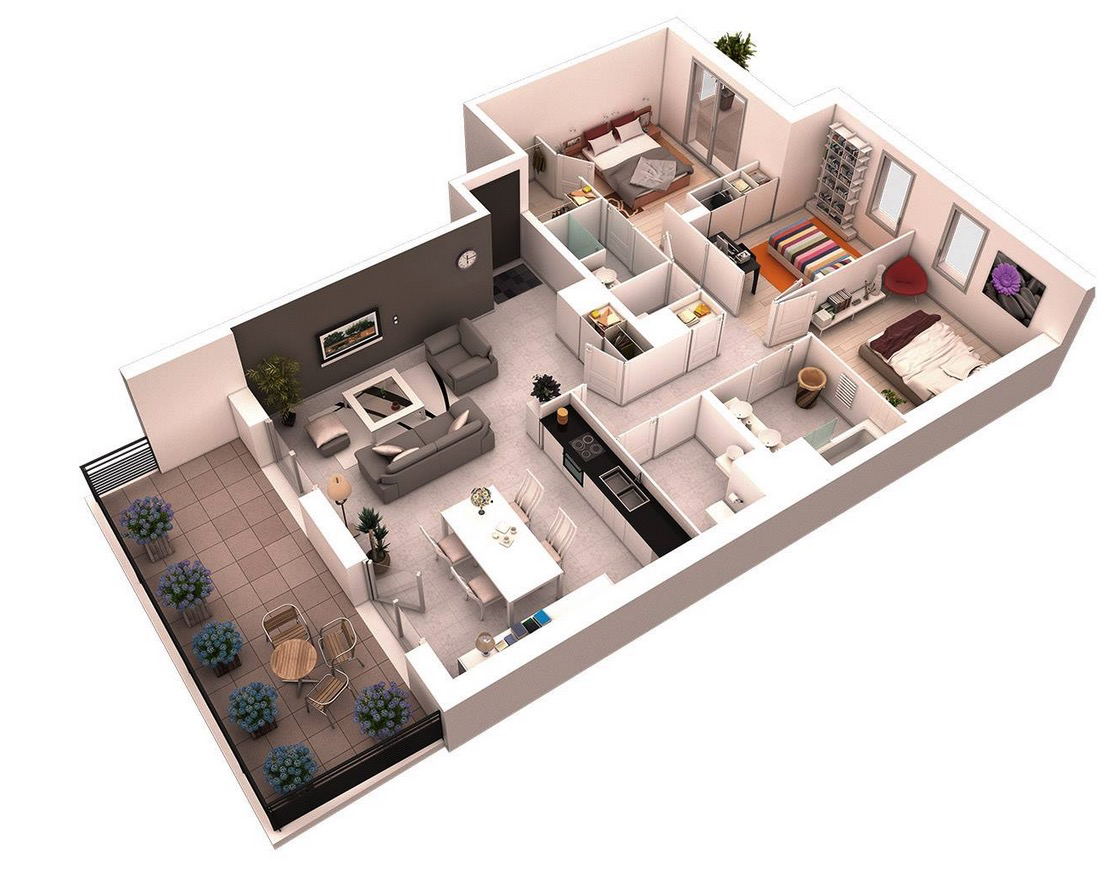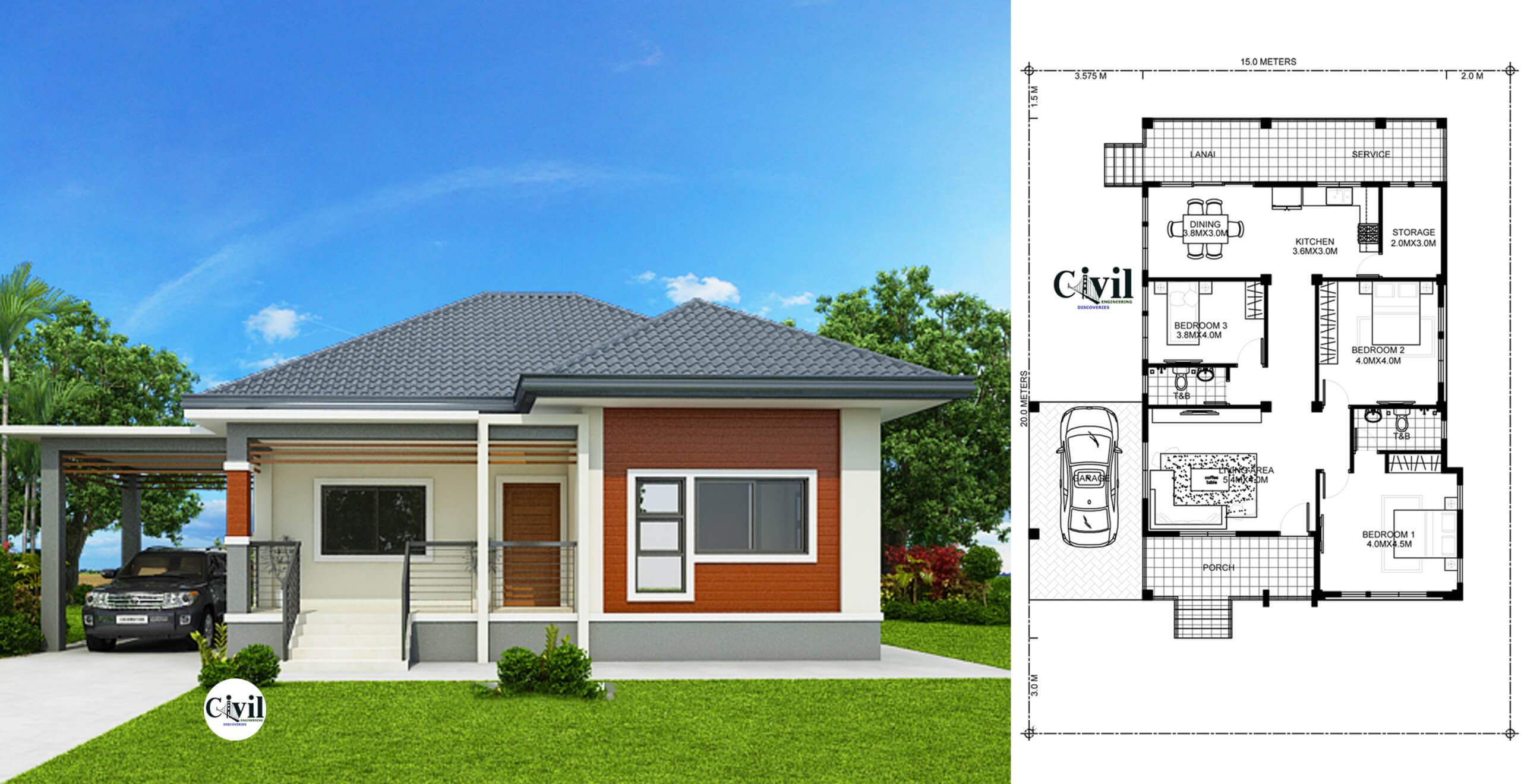Understanding Simple House Plans: Simple House Plans 3 Bedroom 2 Bath

Simple house plans offer a practical and efficient approach to home design, prioritizing functionality and affordability over elaborate details. They are particularly well-suited for first-time homebuyers, those on a budget, or anyone seeking a comfortable and manageable living space.
Benefits of Choosing a Simple House Plan
Simple house plans offer numerous benefits, making them a popular choice for many homeowners.
- Affordability: Simple plans typically involve fewer materials and less labor, resulting in lower construction costs. This is especially beneficial for budget-conscious individuals.
- Ease of Construction: The straightforward design of simple plans makes them easier and faster to build, minimizing construction time and associated costs.
- Reduced Maintenance: Simpler designs often feature fewer intricate details and complex elements, leading to less maintenance and repair requirements over time.
- Flexibility: Simple plans provide a foundation for customization. You can personalize the layout and finishes to suit your specific needs and preferences.
Common Features in Simple 3-Bedroom, 2-Bathroom House Plans
Simple 3-bedroom, 2-bathroom house plans often share common features that prioritize functionality and space optimization.
- Open Floor Plan: This design maximizes natural light and creates a sense of spaciousness by eliminating walls between the kitchen, dining, and living areas.
- Efficient Kitchen Layout: The kitchen is typically designed with a practical layout, including a work triangle between the sink, stove, and refrigerator, maximizing functionality and ease of movement.
- Master Suite: The master bedroom often includes a private bathroom and walk-in closet, providing a retreat-like atmosphere.
- Guest Bedrooms: The remaining bedrooms are typically designed for comfortable sleeping and storage, catering to guests or family members.
- Two Full Bathrooms: The inclusion of two full bathrooms ensures convenience and privacy for residents and guests.
- Laundry Room: A dedicated laundry room provides a designated space for washing and drying clothes, minimizing clutter and maximizing functionality.
Architectural Styles Suitable for Simple House Plans
Simple house plans can be incorporated into various architectural styles, allowing for diverse aesthetic expressions.
- Modern: Modern style emphasizes clean lines, open spaces, and a minimalist approach. Simple plans are well-suited for this style, as they prioritize functionality and lack excessive ornamentation.
- Contemporary: Similar to modern, contemporary style embraces simplicity and functionality, often featuring large windows, flat roofs, and geometric shapes.
- Ranch: This style is characterized by a single-story design, often featuring a low-pitched roof and a simple, rectangular footprint. Simple plans are ideal for achieving this style, as they often feature a straightforward layout.
- Craftsman: Craftsman style emphasizes natural materials, handcrafted details, and a focus on functionality. Simple plans can be adapted to this style by incorporating elements like exposed beams, built-in shelves, and a welcoming porch.
Design Considerations for Simple House Plans

Designing a simple house plan requires careful consideration of space utilization, functionality, and aesthetics. A well-designed plan can maximize living space, optimize flow, and create a comfortable and inviting home.
Space Maximization in Simple House Plans
Maximizing space in a 3-bedroom, 2-bathroom layout involves strategic planning and efficient use of square footage. This can be achieved by:
- Open Floor Plans: Combining living, dining, and kitchen areas creates a sense of spaciousness and allows for flexible furniture arrangements.
- Multifunctional Spaces: Designing rooms that serve multiple purposes, such as a home office that doubles as a guest room, can increase functionality without sacrificing space.
- Built-in Storage: Incorporating built-in shelves, cabinets, and closets maximizes storage capacity and minimizes the need for bulky freestanding furniture.
- Vertical Space: Utilizing vertical space with tall cabinets, bookshelves, and lofted beds can create a sense of openness and maximize storage potential.
Layout Variations for Simple House Plans
Different layouts offer unique advantages and cater to specific needs. This table showcases four common layout variations for a simple house plan:
| Layout | Living Area | Bedrooms | Bathrooms |
|---|---|---|---|
| Open Concept | Combined living, dining, and kitchen | Separate bedrooms with closets | Hallway bathroom and master bathroom |
| Traditional | Separate living, dining, and kitchen | Separate bedrooms with closets | Hallway bathroom and master bathroom |
| Split-Level | Living area on the main level, bedrooms on the lower level | Separate bedrooms with closets | Hallway bathroom on the main level, master bathroom on the lower level |
| L-Shaped | Living area and kitchen in an L-shape, with dining area in the center | Separate bedrooms with closets | Hallway bathroom and master bathroom |
Efficient Kitchen Designs for Small Homes
Small kitchens can be functional and stylish with careful planning.
- Galley Kitchen: This design features two parallel countertops with appliances and cabinets along the sides, maximizing space and creating a streamlined workspace.
- U-Shaped Kitchen: This layout features three sides of countertops and cabinets, creating a functional and efficient work triangle.
- Island Kitchen: Incorporating an island can provide additional counter space, storage, and seating, while still maintaining an open and airy feel.
- Open Shelving: Replacing some upper cabinets with open shelving can visually expand the space and create a more airy feel.
- Multifunctional Furniture: Utilizing furniture with multiple purposes, such as a table that doubles as a kitchen island, can maximize space and functionality.
Building a Simple House

Building a simple house is a rewarding process that requires careful planning and execution. From the initial design to the final touches, each step plays a crucial role in creating a comfortable and functional living space. This section explores the essential steps involved in building a simple house, common building materials, and the importance of energy efficiency in simple house designs.
Essential Steps in Building a Simple House, Simple house plans 3 bedroom 2 bath
Building a simple house involves a series of interconnected steps, each requiring meticulous attention to detail. These steps ensure a smooth construction process and a high-quality finished product.
- Planning and Design: The initial stage involves defining the scope of the project, including the size, layout, and desired features of the house. This step often involves consulting with architects or designers to develop detailed blueprints and specifications.
- Site Preparation: Once the design is finalized, the construction site needs to be prepared. This involves clearing the land, grading the site, and excavating for the foundation.
- Foundation Construction: The foundation serves as the base for the entire house, providing structural support and stability. Common foundation types include concrete slabs, crawl spaces, and basements.
- Framing: The framing process involves erecting the structural skeleton of the house, using wood or steel beams and studs. This framework provides support for walls, floors, and ceilings.
- Roofing: The roof protects the house from the elements and provides structural integrity. The roofing system includes rafters, sheathing, underlayment, and roofing shingles or tiles.
- Exterior Finishes: Once the framing is complete, the exterior of the house is finished. This includes siding, windows, doors, and any other decorative elements.
- Interior Finishes: The interior of the house is then finished with drywall, paint, flooring, cabinets, and fixtures.
- Plumbing and Electrical: These systems are installed during the construction process, providing water, sanitation, and electrical power.
- HVAC: The heating, ventilation, and air conditioning (HVAC) system is installed to regulate the temperature and air quality within the house.
- Landscaping: The final step involves landscaping the surrounding area, adding greenery, pathways, and other outdoor features.
Common Building Materials
Building a simple house requires a variety of materials, each with specific properties and applications. Understanding the characteristics of these materials is essential for making informed decisions during the construction process.
- Wood: Wood is a versatile and renewable material commonly used in framing, flooring, siding, and roofing.
- Concrete: Concrete is a durable and versatile material used in foundations, walls, floors, and driveways.
- Steel: Steel is a strong and durable material used in framing, roofing, and other structural components.
- Brick: Brick is a traditional building material used for exterior walls, fireplaces, and other decorative features.
- Stone: Stone is a natural and durable material used for exterior walls, fireplaces, and landscaping.
- Glass: Glass is used for windows, doors, and other transparent or translucent elements.
- Insulation: Insulation is used to reduce heat transfer, improving energy efficiency and comfort.
- Drywall: Drywall is a common material used for interior walls and ceilings.
- Paint: Paint is used to protect and decorate interior and exterior surfaces.
Energy Efficiency in Simple House Designs
Energy efficiency is a critical consideration in simple house designs, as it can significantly reduce energy consumption and save on utility costs. Incorporating energy-efficient features can enhance the overall sustainability and environmental impact of the house.
Energy-efficient homes use less energy to heat, cool, and power the home, resulting in lower utility bills and a reduced carbon footprint.
- Proper Insulation: Adequate insulation in walls, ceilings, and floors helps prevent heat loss in the winter and heat gain in the summer, reducing energy demand for heating and cooling.
- Energy-Efficient Windows and Doors: Double- or triple-paned windows with low-e coatings can significantly reduce heat transfer, minimizing energy loss.
- Solar Panels: Installing solar panels on the roof can generate electricity from sunlight, reducing reliance on traditional energy sources and lowering energy bills.
- Efficient Appliances: Choosing energy-efficient appliances, such as refrigerators, washing machines, and dryers, can significantly reduce energy consumption.
- LED Lighting: LED lights are more energy-efficient than traditional incandescent bulbs, consuming less energy and lasting longer.
- Proper Ventilation: Adequate ventilation helps maintain a comfortable indoor temperature and air quality, reducing the need for excessive heating or cooling.
Simple house plans 3 bedroom 2 bath – Dreaming of a simple house plan with three bedrooms and two baths? While those plans might be perfect for a family, sometimes a fresh start is needed. If you’re looking for a new beginning, consider exploring 3 bedroom second chance apartments near me.
These apartments offer a chance to rebuild, and who knows, maybe after a while, you’ll be ready to tackle that three-bedroom, two-bath house plan with renewed energy!
While simple house plans for a 3-bedroom, 2-bathroom dwelling might seem like a dream, the reality of finding a spacious and affordable home can be a bit of a nightmare. Especially if you’re looking in a bustling metropolis like New York City.
If you’re dreaming of that urban lifestyle, you might want to consider a different approach and check out the options for cheap 3-bedroom apartments in New York City , where you can trade a backyard for a rooftop view. Of course, a simple house plan can always be adapted to suit your needs and budget, so don’t give up on your dream home just yet!